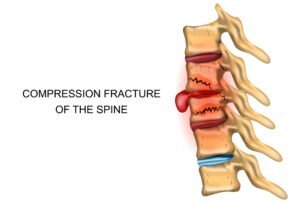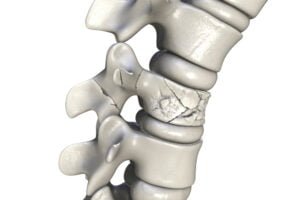A spine fracture can result from very minor accidents or injuries. Many of these wounds won’t ever need surgery, but large fractures can have serious long-term consequences if not addressed right away. The severity of spine fractures can range from painful compression fractures, which are frequently observed in osteoporotic patients after minor trauma, to more serious wounds like burst fractures and fracture-dislocations, which happen after car accidents or falls from great heights. These serious wounds typically cause spinal instability, increasing the risk of discomfort and harm to the spinal cord.
Vertebral compression fractures can be excruciatingly painful and are caused by osteoporosis, or bone thinning. Bracing and narcotic drugs, which typically result in persistent discomfort and worsening deformity, were the only treatments available until recently.
What causes the spine fracture?
When the spine is subjected to an external force, such as that caused by a fall, the force may be greater than the capacity of the bone within the vertebral column to support the load. A compression fracture could arise from this because it could cause the front portion of the vertebral body to crush. Burst fractures happen when the vertebral column as whole fractures.
If the compression is slight, you won’t feel any discomfort, and the deformation won’t be severe. You will endure excruciating pain and develop a slumped forward deformity if the compression is severe and affects the spinal cord or nerve roots.
Types of Spinal Fractures
Compression, burst, flexion-distraction, and fracture-dislocation are only a few of the numerous types of spinal fractures. There is a description of each of these fracture forms.
Compression Fracture
Compression fractures are especially common in those with osteoporosis or people whose bones have already been compromised by other illnesses (such as bone cancer). The vertebra can withstand a certain amount of pressure, but if that pressure is suddenly applied in large amounts, the bone may not be able to withstand the strain. The vertebra may then shatter.

A variety of compression fractures include wedge fractures. A wedge fracture occurs when a portion of the vertebra, typically the anterior (front) portion, collapses and takes on the shape of a wedge.
Burst Fracture

Serious trauma results in burst fractures (eg, car accidents). They occur when strong stresses effectively crush the vertebra. In contrast to compression fractures, the entire vertebra is fractured. A burst fracture involves several fractures in the vertebra. Because the vertebra is fully crushed, bone fragments may disperse and harm the spinal cord. Compression fractures are less severe than burst fractures.
Flexion-distraction Fractures
A flexion-distraction fracture may occur if your body is forced forward during an automobile collision. Your spine is designed to bend forward, but if you suddenly move forward and put a lot of pressure on your spine, one or more vertebrae could break. When considering the three-column model, flexion-distraction fractures typically involve the middle and posterior columns. Below is an illustration of a flexion-distraction fracture.
Fracture-dislocation
A fracture-dislocation occurs when any of the aforementioned fractures occur and the vertebra(e) moves noticeably (dislocation). These fractures, which frequently affect all three columns from the three-column idea, render your spine incredibly unstable.
Stable and Unstable Fractures
Stable Fractures
Neurologic (nerve) issues and spinal deformities are not brought on by stable fractures. The spine can nevertheless support and distribute your weight reasonably well with a stable fracture (albeit not as well as it would if there were no fracture).
Unstable Fractures
The spine has a tough time supporting and distributing weight when there are unstable fractures. Unstable fractures have the potential of developing and resulting in more harm. They could result in spinal malformation as well.
Symptoms of a Spinal Fracture
Back discomfort is the primary symptom of a spinal compression fracture. It could begin gradually and progressively get worse or it might start off quickly and sharply.
Along with back pain, spinal compression fractures also can cause:
- Standing or moving around makes the pain worse, although lying down helps somewhat.
- Difficulty with body bending or twisting.
- Decrease in height
- Your spine has a bent, stooping curvature.
Usually, the discomfort develops after a minor back strain while performing an ordinary task like:
- Lifting a grocery bag
- Stooping to pick up something from the floor
- Tripping over something or making a mistake
- Removing a suitcase from a car’s trunk
- Lifting a mattress’ corner when changing sheets
Different Spinal Compression Fractures symptoms
A spinal compression fracture will often become less painful as the bone heals. It can take up to two or three months. Others will continue to experience pain even after the fracture has healed. Some sufferers with spinal compression fractures experience absolutely no symptoms. The cracks could appear so gradually that there would be little to no discomfort. Others may experience pain that persists in the affected area of their back.
Signs of multiple Spinal Compression Fractures
Your spine will change significantly if you suffer many spinal compression fractures. Due to the fissures, a portion of your vertebrae may collapse since it is unable to sustain the weight of your spine. That might alter how your body functions.
These signs include:
loss of height: The spine becomes somewhat shorter with each spinal bone fracture. You will eventually appear shorter once numerous vertebrae have fallen out.
Kyphosis (curved back): The spine bends forward as a result of the vertebrae collapsing into a wedge shape. Eventually, when your body tries to adjust, you’ll experience neck and back aches.
Stomach problems: Shorter spines can compress the stomach, which can lead to digestive issues like constipation, a lack of appetite, and weight loss.
Hip pain: Your rib cage is located nearer to your hip bones because of the shorter spine. It may hurt if the bones are grinding against one another.
Breathing difficulties: If the spine is significantly compressed, it may cause your lungs to malfunction and cause breathing difficulties.
Treatment of Spinal Fracture
Most fractures are treated by keeping the patient immobile for up to 12 weeks in a brace or corset, but severe instances may necessitate surgery.
A recent surgical treatment called vertebroplasty may be used to treat compression fractures. A catheter is inserted by the surgeon during this surgery into the compressed vertebra. The shattered vertebrae are injected with bone cement via a catheter, which hardens and stabilizes the vertebral column. This method has been demonstrated to lessen or completely remove fracture pain, allowing for a speedy return to activity and halting bone loss from prolonged bed rest.
Under X-ray guidance, a tube is inserted into the spinal column during kyphoplasty, and then an inflatable bone tamp is inserted into the tube.
The removal of a fractured vertebra and replacement with a plate, screws, or cage can also result in stabilization.
Orthopedic implants used in Spine Fractures
- Pedicle Monoaxial Screw
- Pedicle Polyaxial Screw
- Pedicle Hook
- Lumina Hook Reduced Distance
- 3.0mm Transverse Connecting Rod
- 5.5mm Rod for Pedicle Screw
- TLIF Type ||
- PLIF Cage
In a nutshell…
Spinal surgery needs orthopedic implants which ensure a shorter recovery time, less pain, and reduced risk of complications, Zealmax Ortho is an orthopedic implant and instrument Manufacturer in India. We are dedicated to the innovation, design, and development of novel, clinically relevant, and state-of-the-art implants that give lives a new chance to stand strong.


